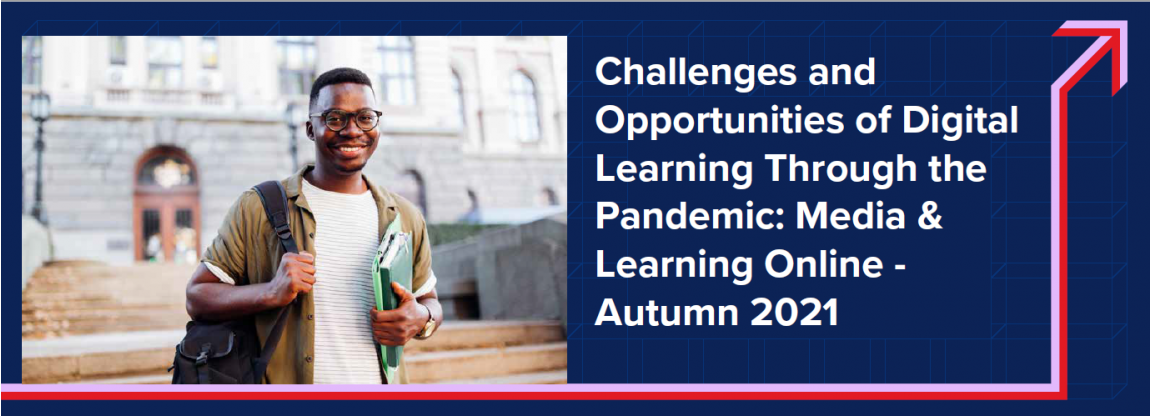Challenges and Opportunities of Digital Learning Through the Pandemic: Media & Learning Online - Autumn 2021
The Media and Learning Association's Autumn Conference welcomed a host of Teaching & Learning specialists from Higher Education, sharing learnings and experiences of how they are utilising technology to support student engagement. Emma Hill, Partnership Product Manager, reflects on the key themes that emerged from discussions.


There is no single 'best practice' for hybrid learning
Although many institutions moved to ‘hybrid teaching’ during the pandemic, what became clear through the sessions was that each institution offered a slightly different mix. For some it was combining in-person and virtual learners, for others it involved flipping the classroom with virtual learning before face-to-face lectures, and for others again, it was a mix of face-to-face seminars following online recorded lectures.
While decisions would have been in part driven by the degree of local restrictions at various points during the pandemic, the sheer range of approaches raises the question of how and why choices related to hybrid teaching and learning were made, by whom, and how ideas and best practice are disseminated.
Research by Alexandra Mihai (Maastricht University), Laura Czerniewicz (University of Cape Town) and Deborah Arnold (AUNEGe) gives an interesting perspective on how ‘Teaching & Learning’ as an area of practice is approached at different institutions. Where it sits in the organisational structure is important – with responsibility variously lying within Innovation, EdTech, Library, Digital Learning, or Support teams.
They found that for institutions with a teaching focus, Teaching & Learning centres tended to be centralised, whereas more research-focused institutions had a decentralised approach. There are benefits to both approaches, as centralised provides cross-discipline support and standardisation of best practice and decentralised allows space for varied innovation and disciplinary contextualisation. However, the authors noted the benefit of Academic & Professional teams working cross-functionally to ensure research, innovation and importantly quality teaching and learning delivery.
The pandemic brought opportunities as well as challenges
Another major theme of the conference was the opportunity to continue using learning technology purposefully as we move away from ‘surviving to redesign,’ to quote Tracy Poelzer (University of Groningen). Tracy talked about how technology is a tool, rather than a learning outcome, and how educators need to look at how they can use one to support the other. She also highlighted the opportunity technology provides for us to rethink assessment, moving from traditional to alternative means in order to better achieve our learning outcomes. For Anas Ghadouani (The University of Western Australia), it is the way in which technology enables collaboration that is the most exciting, providing connection with students in a multi-lateral way not unilateral way as in traditional chalk and talk.


Next Steps:
In order to fully capitalise on the potential of technology, institutions will need to turn their attention to strategy and planning, with the following areas identified by panellists and delegates as most important:
- Supporting faculty delivering online teaching
- Thinking more about what it means to learn virtually – not just moving the lecture experience online but developing asynchronous learning opportunities.
- Refining and creating content now that educators are more familiar with tools
- Investing not only in synchronous teaching but in online and quality content.
- Embracing blended approach as beneficial
- Scaling up and standardising offering across faculties
The future of digital learning in Higher Education
There was also much discussion about how the use of technology in Higher Education might continue to evolve and shape the sector moving forward – from greater globalisation to more personalised teaching for students. This future is one that everyone at the conference was excited about crafting. In particular, participants believed that technology could help enhance and build on the current HE offering in the following ways:
- Greater focus on lifelong learning and professional development
- Enabling micro-credentialling and choice in digital course options for affordability
- Increasing accessibility for international students and opportunities to expand the market
- Inclusion of international instructors in delivery
- Increased Postgraduate offering being blended or fully online
- Ongoing online offering for accessibility
- Enhanced collaboration between institutions


Next steps:
In order to enact the kind of cultural change necessary for the sector to evolve and fully embrace the benefits that digital learning can provide, institutions need to adopt an inclusive and careful approach to change management. Suggestions from panellists of how this can be achieved included:
- Using technology advocates from within the faculty to share and support peers to use technology appropriately
- Reviewing what technology is in use with the aim of simplifying where possible and making it usable without the need for lots of ongoing support.
- Auditing the technical skills of the students too, making sure accessibility for all is taken into account.
- Taking an iterative approach, with small experiments and improvements that add up over time to have a larger impact.
Providing choice for students as the customer


Another clear benefit of digital learning is how it provides choice to students as consumers as to how they learn and flexibility in when they learn. Utilising digital tools supports personalisation of learning to their individual needs, catering to every part of the personalised learning formula of just in time, just enough and just for me. Feedback on what students say they like about digital learning includes:
- It provides access options so they can watch come back to content easily and it provides anytime access.
- Being able to work from home and the freedom to learn in a more modular way.
- More engagement than with chalk and talk, for example through the interaction tools available in online sessions delivered through video conferencing software.
- Flipped classroom approach allowed synchronous face to face time to be spent on debate and discussion, things that benefit from being together and collaborating.
Partnering with McGraw-Hill
While the pandemic has brought a lot of challenges, it has also clearly brought opportunities to build upon the learnings from digital teaching over the past couple of years. From here, it is about how these opportunities will be harnessed in order to create improvements in Higher Education offerings. With our expertise in digital learning through our products like, Connect, Smartbook and ALEKS, McGraw Hill can help you adopt the valuable aspects of digital learning for students success.
Fill out the form below to speak with one of our team about how to best meet your needs.

